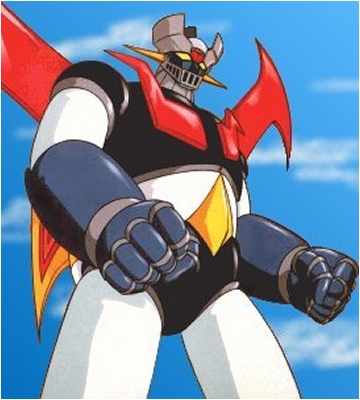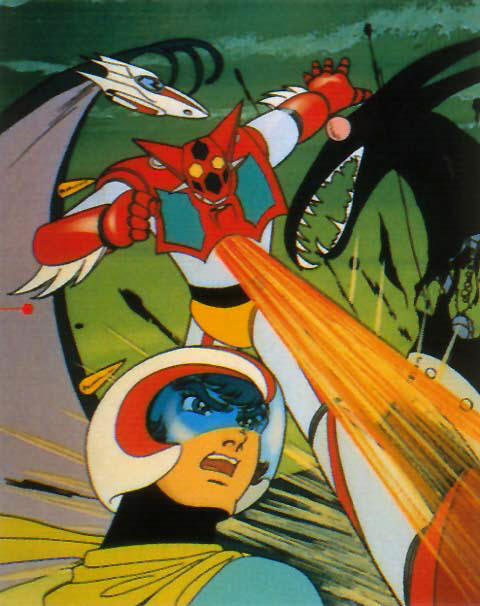History
Super Robots represent the more extravagant side of robot anime. While "Real Robots" (generally referred to as mecha) generally attempt to remain within a certain realm of realism, Super Robots focus more on flashy, over-the-top designs and weaponry. Shows featuring Super Robots were the only robot shows of the 1970s, but became much less prominent once Mobile Suit Gundam started the Real Robot movement in Japan. Recently, however, Super Robots have made a comeback in anime.
Characteristics
As opposed to Real Robots, which use more modest weapons like machine guns, cannons, beam rifles, and small-scale beam swords, Super Robots feature impractical, high-powered, massively-damaging attacks. Rocket Punches are par for the course, as are eye beams, chest blasters, oversized swords, axes, shuriken, arrows, yo-yos, tops, etc. Many of these weapons seem to be voice-activated...or at the very least, are called out by the pilot before they are used.
Several Super Robots are actually amalgamations of several smaller robots, formed through an unnecessarily intricate combination sequence. In these robots, each member of the team is usually responsible for a separate part of the combined robot, such as one person for the legs, one person for the arms, and one person to call out attacks.
Notable Super Robot Anime/Manga
Mazinger Z (1972)
 Mazin Go!
Mazin Go! Mazinger Z, created by Go Nagai, was the first Japanese series to feature a robot piloted via cockpit and is therefore seen as the first true Super Robot franchise. The titular robot was created by Dr. Juuzou Kabuto; Juuzou is eventually killed, but not before revealing the robot to his grandson Kouji Kabuto. Mazinger Z stood against Dr. Hell's forces, decimating them with attacks such as the Rocket Punch, Koushiryoku (Photon) Beam, and Breast Fire.
Mazinger Z's success inspired other anime and manga studios in a way that previous robot series Tetsujin-28/Gigantor and Giant Robo did not. Mazinger Z's traits, including the variety of weapons (and their mostly English names), the hot-blooded pilot, and the "mid-season upgrade," are used even in modern Super Robot series. While the Mazinger series continued with Great Mazinger and Grendizer, the company behind Mazinger Z created another heavily-influential robot series...
Getter Robo (1974)
 Change, Getter-1! Switch On!
Change, Getter-1! Switch On! Getter Robo was the first Super Robot to combine from several smaller machines, in this case airplanes. When the three planes combined as Getter-1, Getter took a shape suitable for aerial combat, using its Getter Beam to waste away the enemy machines. As Getter-2, Getter was equipped with drills and became much faster to the point to where it could create afterimages. As Getter-3, Getter became heavy, suited for underwater battles. Musashi, Getter-3's pilot, was a skilled martial artist, and could use his Daizetsuzan Oroshi technique to toss the enemy.
Teamwork is a major theme in Getter Robo, as the Getter Team must work together to exploit each Getter form's strengths during their battles against the Dinosaur Empire.
Super Electromagnetic Robot Combattler V (1976)
 V! V! V! Victory!
V! V! V! Victory! The titular robot was one of the first, if not the first, to "realistically" combine (Getter Robo morphed together in a manner that made no logical sense). Wielding a massive array of weapons, including Choudenji Yo-Yo, Atomic Burner, Battle Chainsaw, and Choudenji Spark, Combattler fought against the machines of the Campbellians. Combattler's finisher is Choudenji Tatsumaki, where it entraps the enemy in an electric whirlwind, followed by Choudenji Spin, where drills emerge from Combattler's hands as the robot tears through the enemy.
Beast King Golion (1981) / Lion Voltron (1984)
 Form Blazing Sword!
Form Blazing Sword! Golion, while not notable to Japan, is perhaps the most recognizable Super Robot in the United States thanks to its adaption into Voltron; its popularity was so high, that several episodes were created specifically for the American market. The robot itself is initially sentient, but is broken apart by a goddess (in Golion) or Witch Haggar (in Voltron). Its most famous attack is the Blazing Sword (Juuouken), which was used to finish off many a Robeast.
Mobile Fighter G Gundam (1994)
 This hand of mine is burning red! Its loud roar tells me to grasp victory!
This hand of mine is burning red! Its loud roar tells me to grasp victory!Mobile Fighter G Gundam was the first Gundam series not related to the Universal Century timeline; it also gained notoriety for being a Super Robot show in the very franchise that started the "Real Robot" movement. Best described as Dragon Ball Z or Street Fighter featuring robots, the Mobile Suits in this series serve as mere extensions of their neigh-superhuman pilots. The series follows Domon Kasshu, a young martial artist who seeks to both find his brother and win the 13th Gundam Fight for his country. His finishers, Shining Finger and Erupting Burning Finger (Bakunetsu God Finger), are high-powered grabs that could cause its target to explode.
The King of Braves GaoGaiGar (1997)
 Disappear into light!
Disappear into light! The last of the Braves series, GaoGaiGar was intended for younger audiences but gained a large following of older mecha fans. Unlike many anime released shortly after Neon Genesis Evangelion, GaoGaiGar is a fairly simple tale of good-verses-evil. The title robot, literally powered by courage, is piloted by Guy Shishiou and stands against the Zonder threat. GaoGaiGar's signature attacks are Hell and Heaven, where Guy combines offensive and defensive power to constrict the enemy before ripping out its core, and Goldion Hammer, which causes the enemy disappear in a burst of light.
On a side note, GaoGaiGar shares continuity with Betterman, a monster series that features much more "realistic" robots known as Neuronoids.
Tengen Toppa Gurren Lagann (2007)
 Who the hell do you think I am?!
Who the hell do you think I am?! Perhaps the most well-known Super Robot show made in the last decade, Gurren Lagann is all about being as over-the-top as possible - and then shattering the viewer's definition of "possible" as it reaches even greater heights. Starting with the lowly Lagann, more and more machines come under the control of the protagonists, culminating in a robot so massive that it can grasp galaxies in its hands. Like GaoGaiGar, the title robot runs off of pure courage and spirit.
Super Robots In Video Games
Aside from various licensed titles, the Super Robot Wars series of Strategy RPG's brings together robots of all types; for most Super Robot anime, SRW is the only video game representation that they have received. For the sake of balance, Super Robots weaknesses are typically exaggerated so that they don't outclass Real Robots.
Log in to comment